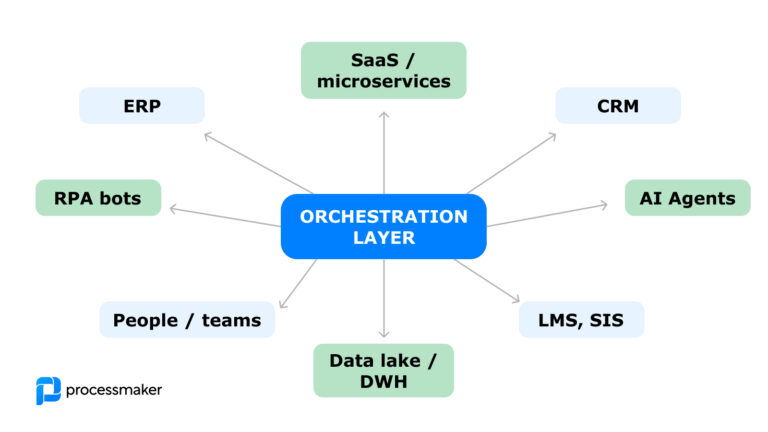For years, automation meant scripting a task or two, wiring up a form, or deploying a bot to push data between apps. That helped, but today’s stack is sprawling, data sits in dozens of systems, and AI agents are starting to act on our behalf. Automating a single workflow is no longer enough.
The competitive advantage now comes from orchestration: coordinating people, systems, data, and AI agents across end‑to‑end journeys so everything moves in concert.
Automation vs. Orchestration
- Automation streamlines individual tasks or workflows (e.g., route an approval, extract a field, post to a system).
- Orchestration is the connective layer that coordinates entire processes across multiple systems (ERP, CRM, LMS/SIS, core banking, EHR, etc.) and teams without ripping and replacing what you already have. It’s how you get data flowing and decisions made across silos.
According to Everest Group, “a holistic process orchestration software helps organizations manage complex workflows that span human workers, digital workers, AI agents, and enterprise systems.”

Why the Shift Now?
- Tool sprawl and complex handoffs. New apps keep arriving; processes cross teams and data sources. Leaders report that complexity is the main blocker to automation at scale, fueling investment in orchestration to manage end‑to‑end work.
- AI agents need governance and coordination. As organizations deploy many AI agents and LLM services, they must connect and control them through an orchestration and integration layer. Otherwise, you get “agent islands” and unpredictable outcomes.
- Expectations are real‑time and omnichannel. Customers, students, and employees expect seamless, cross‑system experiences; orchestration ensures the right event triggers the right action with the right guardrails.
- Budget pressure favors reuse. Orchestration maximizes the systems you already own instead of funding one‑off replacements.
What Good Orchestration Looks Like
- End‑to‑end visibility: Model entire journeys (BPMN 2.0), monitor SLAs, and observe cross‑system dependencies.
- Open by design: First‑class APIs, connectors, eventing, and secure integrations with legacy and cloud systems.
- Human‑in‑the‑loop: Built‑in approvals, exception handling, and auditable trails for compliance.
- Decisioning and rules: Centralized policy logic with simulation and testing before changes go live.
- AI‑ready controls: A place to register AI agents, set policies (data access, citations, human sign‑off), and orchestrate multi‑agent handoffs safely.
Orchestrating AI Agents: From Co‑Pilot to Coordinated Team
Agentic AI is changing the game: agents can research, draft, summarize, reconcile, and trigger actions across systems. But their value compounds when multiple agents are orchestrated—for instance, a triage agent hands off to a risk agent, which calls a document‑extraction agent, before a human reviewer signs off.
Financial services and healthcare are already using multi‑agent patterns to compress cycle time from days to minutes. The key is orchestration: governed coordination, role boundaries, and clean handoffs between agents, systems, and people.
Benefits for your business
- Lower cycle times and higher throughput by coordinating cross‑system handoffs and eliminating manual waits.
- Higher straight‑through processing (STP) with centralized rules, validations, and decisioning executed consistently.
- Reduced integration and maintenance debt by replacing point‑to‑point scripts with a single orchestration layer.
- Stronger governance and compliance with complete, auditable trails of human actions and AI‑agent activity.
- Better customer and employee experiences through real‑time, omnichannel responses that feel seamless end‑to‑end.
A Practical Path: How to Move from Automation to Orchestration
- Pick an end‑to‑end journey (onboarding, claims, transfers, enrollment, order‑to‑cash).
- Map it once and run it many times. Use BPMN to model the whole flow, not just a task.
- Wrap systems with APIs/connectors.
- Centralize rules and data contracts.
- Introduce AI agents intentionally, with guardrails and checkpoints where risk is highest.
- Instrument everything. Track latency, STP, fallouts, and human touchpoints to prioritize the next improvement.
What Leaders Are Predicting for 2025
Industry voices agree: the discipline hasn’t gone away; it has evolved. The fundamentals of modeling, automating, measuring, and improving still matter, but they’re now applied to cross‑system orchestration enhanced by AI. Organizations that embrace this evolution are best positioned to scale automation safely and strategically.
Why ProcessMaker for Orchestration
ProcessMaker delivers orchestration you can trust, combining low‑code process design, rich integration, decisioning, and AI capabilities:
- Agent‑aware orchestration: register, govern, and coordinate AI agents with retrieval sources and human checkpoints.
- Orchestration depth: connectors, templates, decision tables, and AI‑assisted design to speed delivery and simplify maintenance.
- Scale and innovation through combination: In November 2025, ProcessMaker and Decisions merged, uniting orchestration, automation, and discovery into a single powerhouse to accelerate AI‑driven process transformation across industries.
FAQs
What is process orchestration?
Process orchestration is the coordination layer that connects systems, data, people, and AI agents to execute end‑to‑end business processes with clear rules, governance, and observability. It maximizes the tools you already own instead of replacing them.
How is orchestration different from automation?
Automation streamlines tasks; orchestration synchronizes entire processes across multiple tools and teams, ensuring the right event triggers the right action with guardrails and auditability.
Do I need to replace my ERP/CRM/LMS/EHR to adopt orchestration?
No. Effective orchestration integrates with your existing systems, acting as the connective tissue that unifies data and actions across them.
Where do AI agents fit into orchestration?
AI agents handle cognitive work (research, drafting, reconciliation), but they achieve reliable outcomes when orchestrated—with policies, role boundaries, human‑in‑the‑loop checkpoints, and structured handoffs to other agents and systems.
What outcomes should we expect from orchestration?
Expect lower cycle times, higher straight‑through processing, fewer errors, and better compliance because decisions and data quality checks are built into end‑to‑end flows rather than bolted onto single tasks.


